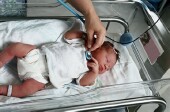Protecting Newborns From a Dangerous Threat
Simple tests and antibiotics can thwart Group B strep, doctors say.
By Dennis Thompson
HealthDay Reporter
|
E-mail this article
Subscribe to news
Printer friendly version
|

(SOURCES: Craig E. Rubens, M.D., Ph.D., professor of pediatrics, adjunct professor of microbiology, and chief, Division of Infectious Diseases, Immunology and Rheumatism, Children's Hospital and Regional Medical Center, University of Washington School of Medicine, Seattle; Diep Nguyen, M.D., obstetrician-gynecologist, Manhattan Beach, Calif., and founder of BabyKick Alliance; Donna Russell, MHA, program director, Global Alliance for the Prevention of Prematurity and Stillbirth, University of Washington School of Medicine's Children's Hospital and Regional Medical Center, Seattle; U.S. Centers for Disease Control and Prevention; Group B Strep International)
THURSDAY, Aug. 28 (HealthDay) -- One in four women in the United States carries a bacterium that could cause a debilitating and life-threatening infection in their newborn babies. And many don't know it.
Infants who contract Group B streptococcus before or during birth can be miscarried, stillborn, or die soon after birth. Those who survive often suffer permanent disabilities such as blindness, deafness, mental retardation and cerebral palsy, according to Group B Strep International, a nonprofit group dedicated to informing the public about the disease.
The good news is, doctors have come up with an effective means of helping to protect newborns from the bacterium.
The bad news is, the strategy adopted in 2002 is hampering development of a vaccine for the germ and could, in the long run, lead to a strain of Group B strep that is resistant to antibiotics.
Babies are infected when they are exposed to Group B strep that's present in the mother's vagina during delivery. A simple swab test can determine whether a pregnant woman carries the germ. And the medical community has adopted an effective antibiotic therapy that will protect her child during delivery.
"It's a short-term solution, because we're using antibiotics more than we'd like, but it is working," said Dr. Craig E. Rubens, a professor of pediatrics, adjunct professor of microbiology and chief of the Division of Infectious Diseases, Immunology and Rheumatism for the Children's Hospital and Regional Medical Center at the University of Washington School of Medicine in Seattle.
Group B strep most commonly causes infection in the blood, the fluid and lining of the brain, or the lungs, according to Group B Strep International.
Testing and antibiotics have led to a 25 percent drop in Group B strep among week-old infants, who are susceptible to a form of the infection called early-onset, according to a recent study published in the Journal of American Medical Association.
But the same number of infants still suffer from late-onset Group B strep infection, and the bacterium has increased by almost 50 percent among many adults. An estimated 21,500 cases of invasive disease and 1,700 deaths were traced to the disease in 2005, according to the study.
Approximately three babies out of every 10,000 births develop late-onset group B strep disease, from one week to several months after birth.
CDC guidelines call for women to be screened for Group B strep between the 35th and 37th week of their pregnancy. The test involves a swab of the rectum and the vagina. If the woman tests positive for the bacterium, she is given intravenous antibiotics hours prior to delivery.
"It reduces the amount of Group B strep in the vagina, so there is less exposure to the baby during delivery," said Dr. Diep Nguyen, an obstetrician-gynecologist in Manhattan Beach, Calif., and founder of BabyKick Alliance, a nonprofit stillbirth prevention organization.
Unfortunately, the strategy has become a bit too popular, experts say.
Only about 25 percent to 30 percent of the 5 million U.S. women pregnant every year should test positive for Group B strep and be administered antibiotics prior to delivery, Rubens said.
"Some of the estimates are more than twice that number are being given antibiotics, because people aren't following the protocol closely," he said.
That's leading to concern that Group B strep could begin showing resistance to antibiotics if doctors don't rein in their use, Rubens said. So far, there's been no resistance shown, although other bacteria that can cause newborn illnesses, such as E. coli, have developed some resistance.
A better solution would be a vaccine to counter Group B strep, protection given to the mother that would pass to the baby during gestation. Several promising vaccines have been developed but are stuck at the testing stage because of the screening/antibiotic strategy, Rubens said.
"It's become an ethical consideration," he said. What woman would forego the safety of her baby to test an experimental vaccine?
While doctors wrestle with the vaccine dilemma, however, the message to expectant mothers remains the same: Get yourself tested, and make sure if you are positive that you get your antibiotics.
"They need to educate themselves," said Donna Russell, program director of the Global Alliance for the Prevention of Prematurity and Stillbirth at the University of Washington School of Medicine's Children's Hospital and Regional Medical Center. "They should get to the hospital early enough to get their antibiotics, and they need to be aware of signs of illness, so they're ready to get their baby in for treatment immediately."
More information
To learn more, visit Group B Strep International. 
Copyright © 2008 ScoutNews, LLC. All rights reserved. 
HealthDayNews articles are derived from various sources and do not reflect federal policy. healthfinder.gov does not endorse opinions, products, or services that may appear in news stories. For more information on health topics in the news, visit the healthfinder.gov health library.